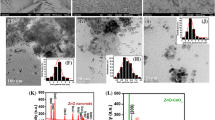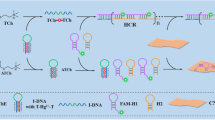Abstract
A highly sensitive fluorescent enzyme array for quantitative acetylcholine detection is developed. The enzyme array has been constructed by spotting of pH sensitive fluorophore 2-phenyl-4-[4-(1,4,7,10-tetraoxa-13-azacycloopentadecyl)benzylidene]oxazol-5-one and acetylcholinesterase doped in tetraethoxysilane / chitosan matrix via a microarrayer. The constructed tetraethoxysilane / chitosan network provided a microenvironment in which the enzyme molecule was active biologically. The optimal operational conditions for the array developed were investigated. The response of the developed biosensor array to acetylcholine was highly reproducible (RSD = 3.27%, n = 6). A good linearity was observed for acetylcholine in the concentrations up to 1 × 10−8 M, with a detection limit of 0.27 × 10−8 M.






Similar content being viewed by others
References
Luong JHT, Male KB, Glennon JD (2008) Biosensor technology: technology push versus market pull. Biotechnol Adv 26:492–500
Maloney JM, Uhland SA, Polito BF, Sheppard NF, Pelta CM, Santini JT (2005) Electrothermally activated microchips for implantable drug delivery and biosensing. J Control Release 109:244–55
Ramanathan M, Simonian AL (2007) Array biosensor based on enzyme kinetics monitoring by fluorescence spectroscopy: application for neurotoxins detection. Biosens Bioelectron 22:3001–7
Tsai H, Doong R (2005) Simultaneous determination of pH, urea, acetylcholine and heavy metals using array-based enzymatic optical biosensor. Biosens Bioelectron 20:1796–804
Xi Y, Liangying Z, Sasa W (1995) Pore size distribution control of porous silica. Sens Actuators, B, Chem 25:347–52
Kuncova G, Podrazky O, Ripp S, Trögl J, Sayler GS, Demnerova K, Vankova R (2004) Monitoring of the viability of cells immobilized by sol-gel process. J Sol-Gel Sci Technol 31:335–42
Salinas-Castillo A, Pastor I, Mallavia R, Mateo CR (2008) Immobilization of a trienzymatic system in a sol-gel matrix: a new fluorescent biosensor for xanthine. Biosens Bioelectron 24:1053–6
Anitha K, Mohan SV, Reddy SJ (2004) Development of acetylcholinesterase silica sol-gel immobilized biosensor-an application towards oxydemeton methyl detection. Biosens Bioelectron 20:848–56
Du D, Chen S, Cai J, Song D (2007) Comparison of drug sensitivity using acetylcholinesterase biosensor based on nanoparticles-chitosan sol-gel composite. J Electroanal Chem 611:60–6
Du D, Chen S, Cai J, Zhang A (2007) Immobilization of acetylcholinesterase on gold nanoparticles embedded in sol-gel film for amperometric detection of organophosphorus insecticide. Biosens Bioelectron 23:130–4
Du D, Chen S, Cai J, Zhang A (2008) Electrochemical pesticide sensitivity test using acetylcholinesterase biosensor based on colloidal gold nanoparticle modified sol-gel interface. Talanta 74:776–82
Paliwal S, Wales M, Good T, Grimsley J, Wild J, Simonian A (2007) Fluorescence-based sensing of p-nitrophenol and p-nitrophenyl substituent organophosphates. Anal Chim Acta 596:9–15
Dan D, Shizhen C, Jie C, Aidong Z (2007) Immobilization of acetylcholinesterase on gold nanoparticles embedded in sol-gel film for amperometric detection of organophosphorus insecticide. Biosens Bioelectron 23:130–4
Doong RA, Tsai HC (2001) Immobilization and characterization of sol-gel-encapsulated acetylcholinesterase fiber-optic biosensor. Anal Chim Acta 434:239–46
Doretti L, Ferrara D, Lora S, Schiavon F, Veronese FM (2000) Acetylcholine biosensor involving entrapment of acetylcholinesterase and poly(ethylene glycol)-modified choline oxidase in a poly(vinyl alcohol) cryogel membrane. Enzyme Microb Technol 27:279–85
Song JM, Griffin GD, Vo-Dinh T (2003) Application of an integrated microchip system with capillary array electrophoresis to optimization of enzymatic reactions. Anal Chim Acta 487:75–82
Drill K, Montgomery DD, Wang W, Tsai JC (2001) Antigen detection using microelectrode array microchips. Anal Chim Acta 444:69–78
Haugland RP (2002) Handbook of fluorescent probes and research products. Molecular Probes, Eugene
Haugland RP (2005) The handbook. a guide to fluorescent probes and labeling technologies, 10th ed. Molecular Probes, Inc., Eugene, pp 935–947
Qin W, Baruah M, De Borggraeve WM, Boens N (2006) Photophysical properties of an on/off fluorescent pH indicator excitable with visible light based on a borondipyrromethene-linked phenol. J Photochem Photobiol, A Chem 183:190–7
Corea N (2007) Edrophonium. Elsevier, Bedford, p 1
Luo C, Saxena A, Ashani Y, Leader H, Radic Z, Taylor P, Doctor BP (1999) Role of edrophonium in prevention of the re-inhibition of acetylcholinesterase by phosphorylated oxime. Chem-Biol Interact 119–120:129–35
Abou-Donia MB, Dechkovskaia AM, Goldstein LB, Abdel-Rahman A, Bullman SL, Khan WA (2004) Co-exposure to pyridostigmine bromide, DEET, and/or permethrin causes sensorimotor deficit and alterations in brain acetylcholinesterase activity. Pharmacol Biochem Behav 77:253–62
Gordon RK, Haigh JR, Garcia GE, Feaster SR, Riel MA, Lenz DE, Aisen PS, Doctor BP (2005) Oral administration of pyridostigmine bromide and hyperzine A protects human whole blood cholinesterases from ex vivo exposure to soman. Chem-Biol Interact 157–158:239–46
Kant GJ, Bauman RA, Feaster SR, Anderson SM, Saviolakis GA, Garcia GE (2001) The combined effects of pyridostigmine and chronic stress on brain cortical and blood acetylcholinesterase, corticosterone, prolactin and alternation performance in rats. Pharmacol Biochem Behav 70:209–18
Servatius RJ, Ottenweller JE, Guo W, Beldowicz D, Zhu G, Natelson BH (2000) Effects of inescapable stress and treatment with pyridostigmine bromide on plasma butyrylcholinesterase and the acoustic startle response in rats. Physiol Behav 69:239–46
Sinton CM, Fitch TE, Petty F, Haley RW (2000) Stressful manipulations that elevate corticosterone reduce blood-brain barrier permeability to pyridostigmine in the rat. Toxicol Appl Pharmacol 165:99–105
Ozturk G, Alp S, Timur S (2007) A fluorescent biosensor based on acetylcholinesterase and 5-oxazolone derivative immobilized in polyvinylchloride (PVC) matrix. J Mol Catal B Enzym 47:111–6
Ozturk G, Alp S, Timur S (2008) Photophysical characterization of fluorescent oxazol-5-one derivatives in PVC and their application as biosensors in the detection of ACh and AChE inhibitor: Donepezil. Dyes Pigm 76:792–89
Öztürk G, Alp S, Ergün Y (2007) Synthesis and Spectroscopic properties of new 5-oxazolone derivatives containing an N-phenyl-aza-15-crown-5 moiety. Tetrahedron Lett 48:7347–50
Schimmelpfennig M, Dornbusch K, Bannert M, Feller KH (2008) Micro-structured devices for chemical sensing of flavor and fragrance. Eng Life Sci 8:415–24
Brückner V, Feller KH, Grummt UW (1990) Application of time-resolved optical spectroscopy. Elsevier Science, Amsterdam, p 120
Author information
Authors and Affiliations
Corresponding author
Rights and permissions
About this article
Cite this article
Ozturk, G., Feller, KH., Dornbusch, K. et al. Development of Fluorescent Array Based on Sol-Gel/Chitosan Encapsulated Acetylcholinesterase and pH Sensitive Oxazol-5-one Derivative. J Fluoresc 21, 161–167 (2011). https://doi.org/10.1007/s10895-010-0700-7
Received:
Accepted:
Published:
Issue Date:
DOI: https://doi.org/10.1007/s10895-010-0700-7




